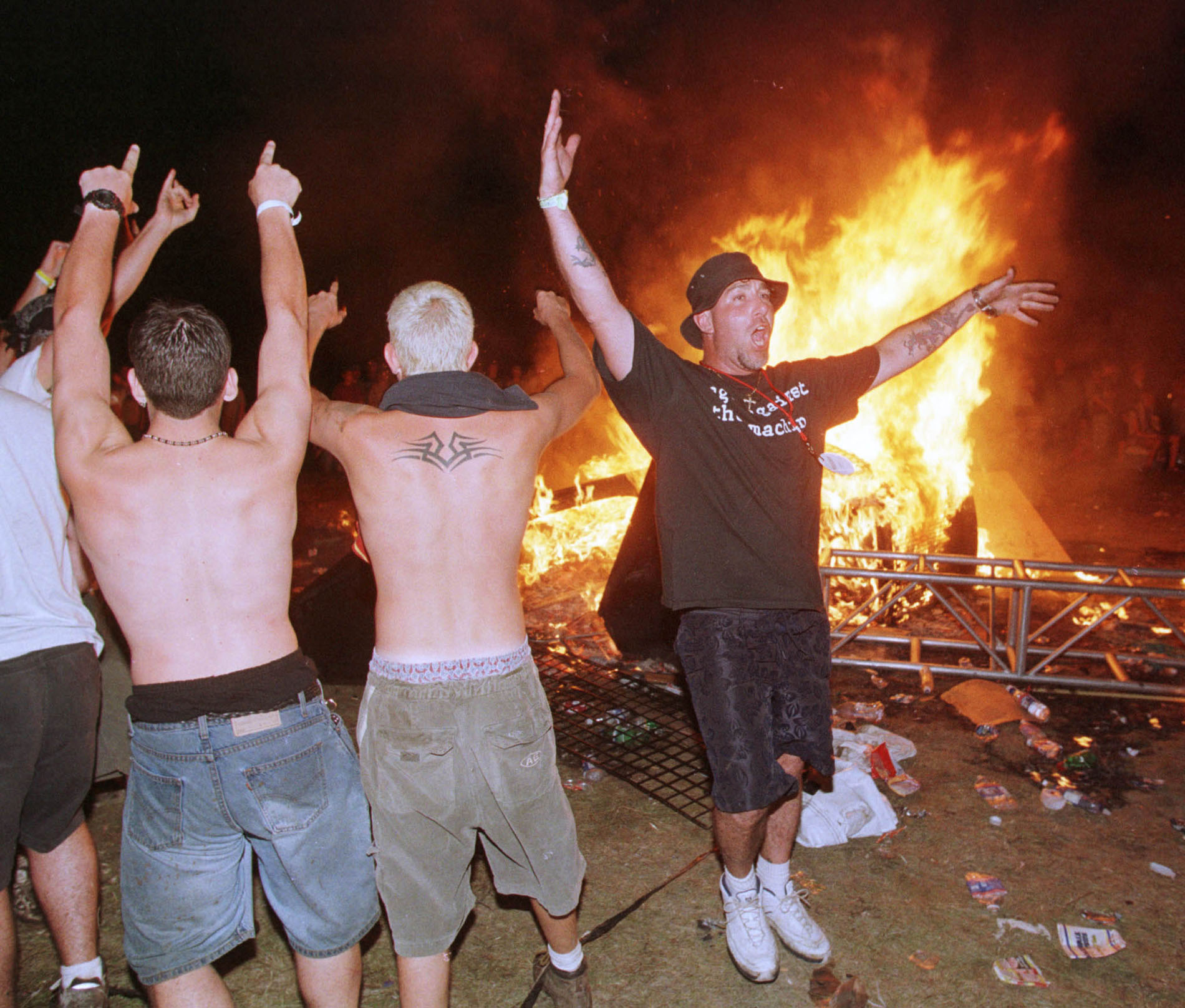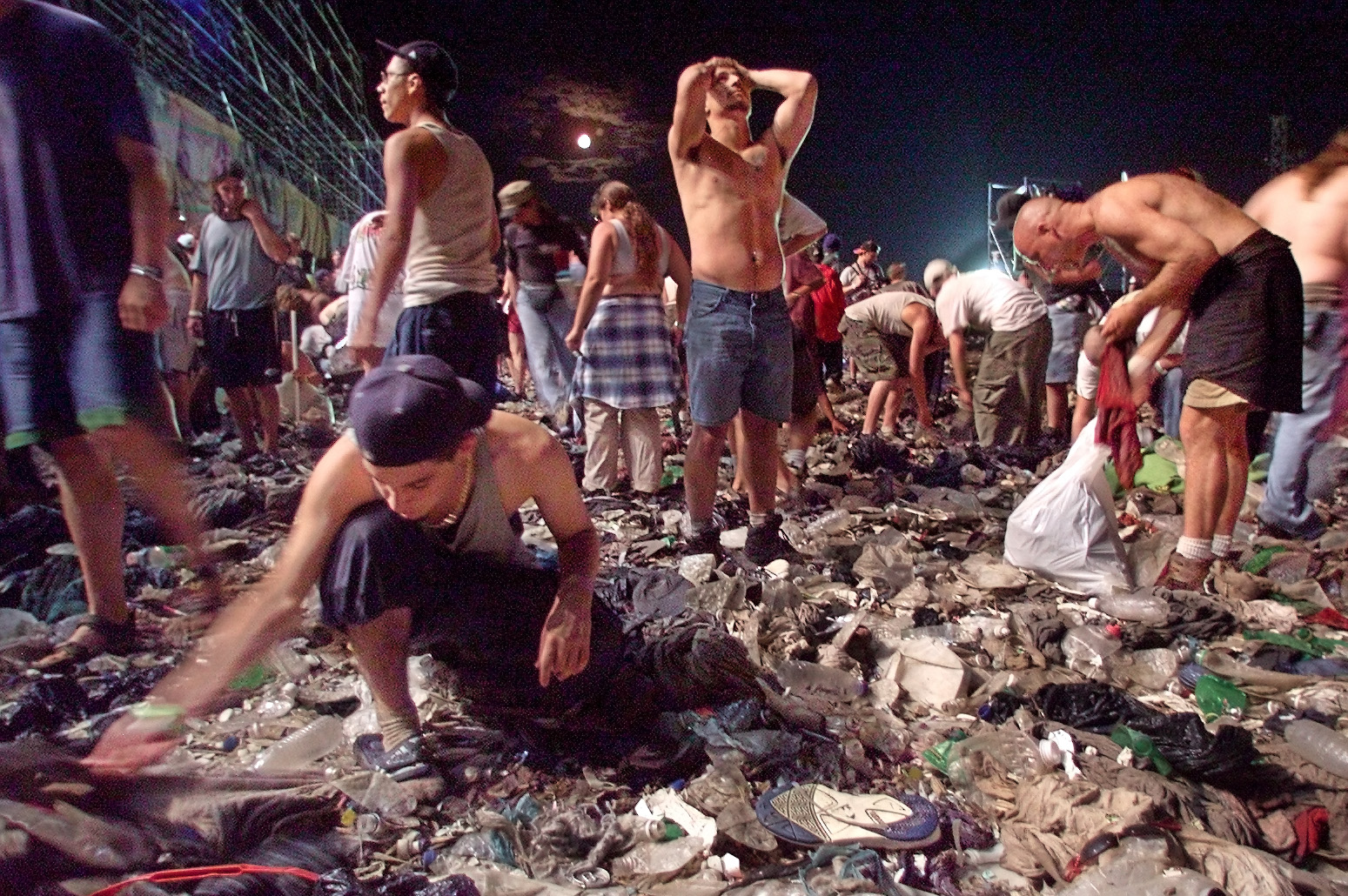Woodstock ’99 Was the Shape of Toxic Masculinity to Come
Credit to Author: Zachary Lipez| Date: Wed, 24 Jul 2019 11:49:57 +0000
1999 was the year that history was supposed to end. “Nuclear War Fear Over Y2K Bug” was one of the more understated headlines that fed into the end-of-the-millennium apocalypticism.
But Y2K failed to bring us back to the Stone Age and, despite Prince’s prophetic exhortations, we pretty much partied the same as we did every other year. It was in that last summer of the century that we bore witness to Woodstock ’99. Looking back on the fifth (after the original, ’79 and ’89’s forgettable renditions, and ’94’s mud-caked Lollapalooza redux) gathering of stardust two decades after it took place, it’s clear that it was this iteration of Woodstock, the one that took place on the hot tarmac at Griffiss Air Force Base in Rome, New York—and not the blissed-out hippie convention of 1969 at the idyllic pastures of Max Yasgur’s farm—that is most relevant to America in 2019.
Woodstock ’99, which transpired July 22–July 25, uh, 1999, was, to be both simplistic and generous, an attempt to recreate the cultural zeitgeist of the original festival. With a lineup covering the entire spectrum of guitar-forward angst merchants, from Rage Against the Machine to Jewel (with a smattering of legacy and hip-hop acts thrown in for verisimilitude), it was supposed to be a generation-defining event, a celebration of “Alternative Nation”-dom, live-streamed by MTV, with $12 pizza. Unlike all the Woodstocks before it, it was also supposed to turn a profit. Instead, a confluence of corporate rapacity and organizational incompetence resulted in an estimated 400,000 attendees, according to TIME, with barely any security or trained oversight, in a space better suited for 50,000. Supplies were minimal and expensive, the hired security was undertrained and overwhelmed, and much of the music was rooted in a rage aimed more at ex-girlfriends than injustice. The exact causes of the riots that unfolded, where hundreds of shirtless festival-goers set fires and overturned cars, have been ascribed to reasons ranging from the heat, lack of grass, overflowing toilets, and uncollected trash to the overpriced ($4 a bottle) and scant supply of water, to the irresponsible encouragement of Insane Clown Posse, Red Hot Chili Peppers, and/or Limp Bizkit. As documented by Maureen Callahan and David Moodie in their classic SPIN postmortem of the event, “Don’t Drink The Brown Water,” the rioting was only quelled by roughly 700 state police in full riot gear—but not before the grounds were aflame, the ATMs were cracked open, and three people were dead, according to MTV.

Now, on its 20th anniversary, Woodstock ’99 is undergoing a critical reexamination and potential historical revision. The Ringer is devoting an eight-part podcast to reexamining the disaster it came to be, while the independently produced Podcast 99 is up to episode 23. Some attendees’ memories of the festival are positive; if the violence that surrounds you doesn’t affect you, empathy is a choice and, worse, kind of a hassle. All the additional analysis of Woodstock ’99 is, of course, welcome, but the basic facts of the festival—rioting, cynical avarice, and multiple sexual assaults—are indisputable, and cannot be mitigated.
There’s no lasting delusion that the peace-and-love Woodstock of 1969 actually succeeded in bringing about a mass embracement of, you know, peace and love. It’s widely considered the apex of the idealism of the 1960s, followed by the queasy hangover of Altamont and the final disillusionment of Watergate. Woodstock ’99 is different in that there has been no cultural or political break from the toxicity it’s come to symbolize; there’s been only a continuous ramping up of national viciousness, a through line of misaligned aggression, leading up to Trump’s America, where gleeful brutality is policy and Kid Rock in the White House isn’t an almost-too-obvious joke. Far more than any hazily romanticized boomer reverie, it’s Woodstock ’99’s fetishization of testosterone and rage, the setting of fires when it’s already hotter than hell, that is our national reality. In Joni Mitchell’s lovely ode to the Summer of Love, she sang, “By the time we got to Woodstock, we were a half a million strong.” Trump rallies don’t draw quite that—but he has a lot of rallies.
But, like most sequels, Woodstock ’99 had disaster baked in from the get go. It was a historical reenactment of a counterculture touchstone, one that came at the tail end of post-Cold War hubris, when Bill Clinton, the first child of the 60s to hold the highest office, was sending cruise missiles into Afghanistan and Sudan, distracting from from the blowjobs he was famously receiving from a White House intern. The economy was strong, there was no marching in the streets, and the stage was set for a festival more MTV culture than counter. With the biggest names on the lineup consisting of Red Hot Chili Peppers, Dave Matthews Band, Live, Kid Rock, and Moby, mediocrity was the best case scenario. (While nostalgia has conspired to rehabilitate the reputation of late-90s alternative rock, popular rock music at the time was abysmal—a wash of power chords, leftover Prodigy beats, and insipid melodies that managed to simultaneously mash up and misunderstand the qualities that made punk, rave, metal, hip-hop, and even the 70s guitar nostalgia of grunge so great.)
The riots at Woodstock ’99 were not political, at least not in their intent. To justify them on the account of overpriced water is akin to justifying voting a racist demagogue into office out of economic anxiety. The riots came from the same destructive, arguably nihilistic, urge that all bullies subscribe to when marching in step with one of their own in the name of “disruption.” The destruction, instigated by whatever circumstance or musician one chooses to blame, was pointedly pointless.
The rampant sexual violence (four rapes investigated by state police, multiple sightings of groping and assault in and out of the mosh pits, and yet no arrests) at the festival also indicated an all-too-familiar reality. Women daring to dress, undress, or dance as they pleased were rewarded with mass abuse, with scant protection from security and zero systemic recourse. Woodstock ’99 didn’t even try to embody such fanciful notions of rock ‘n’ roll as a place where women could feel safe to let it all hang out. Few who have attended any large-scale gathering, let alone a music festival of thousands, are so naîve—but at Woodstock ’99, even decades before #MeToo took off, onlookers were horrified by the open culture of sexual assault.

Sadly, the well-documented, pervasive misogyny of Woodstock ’99 feels like a more relevant antecedent to America in 2019 than the “free love” politics of the original fest. (Even if free love as a concept was entirely illusory, with built-in power imbalances that allowed men to do what they liked under the auspices of an open mind, our nostalgic delusions about its success remain.) The electoral college putting into power a man who has been accused of assault by (at latest rough count) at least 20 women, and brags of “grabbing pussies,” again reifies the ugly resonance of Woodstock ’99 over the fantasy of ’69. The first Woodstock is still considered the Woodstock, the pivotal festival, and its 30th anniversary event is brushed under the rug as an unfortunate footnote. But the cruel reality of the Trump era and the rage and infighting it has stoked within our national identity demands a reversal of these designations.
Angry young men full of imagined grievances have always been a societal force to be feared. Now, whether it’s the crowds shouting “Lock her up!” at Trump rallies or men’s rights activists or self-styled victims of a lack of ethics in the gaming industry, young man-children run amok. It’s depressing but unavoidable to acknowledge that it’s the Limp Bizkit Woodstock that better represents America’s population today. The fact that the baseball hats are now red and worn frontwards doesn’t change the fact that it’s that same hat.
While it’s tempting, for narrative’s sake, to ascribe some sort of prescient foreshadowing in Woodstock ’99’s American carnage, as if ours were a timeline that could be avoided with just the right amount of baby-Hitler-killing, that’s not the case. Maybe the arc of history just curves dumb. It would be too tidy to see our current situation as an endlessly repeating Altamont, with Bikers For Trump all too happily standing in for the rampaging Hells Angels of that End-of-the-Sixties shitshow. All this is not to advocate for the forgetting of the 1969 festival. It’s nice that it happened, and that Joni Mitchell song is forever a jam. But, really, the original Woodstock was the blip, the tie-dyed anomaly, the aberration of hope.
Whether Woodstock ’99 was just one of a million accurately dark reflections of what America has always been, or instead a mile marker in a sea change, depends on one’s view of our nation’s history. Either way, with all due respect to those who might feel the need to maintain the ‘60s totemic legacy, Woodstock ’99—in all its shrill petulance and useless cruelty—is most assuredly who we, as a country, are now.
This article originally appeared on VICE US.